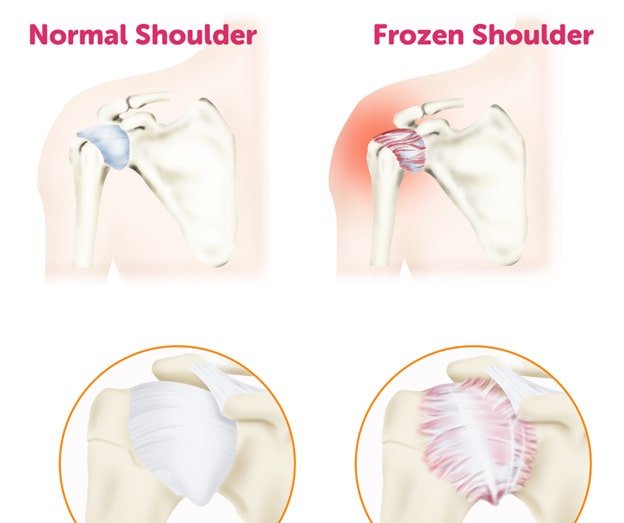Frozen Shoulder
What is it?
Adhesive Capsulitis, AKA “frozen shoulder” is a common condition that affects up to 5% of the Australian population. The condition is more common in woman, with 70% of the affected people being female. A frozen shoulder is often missed or confused with a rotator cuff injury, it has a distinct pattern of symptoms resulting in shoulder pain, loss of shoulder function and eventually stiffness.
What Causes Frozen Shoulder?
There are various theories on what causes frozen shoulder. Unfortunately, there is still much unknown about frozen shoulder. Conditions
such as diabetes, cardiac disease, hyperthyroidism, and hypothyroidism increase the risk of developing frozen shoulder. For example, the incidence of frozen shoulder in diabetics can be up to 20-38%.
Post-surgery is another potentially preventable cause of frozen shoulder. You must comply with your physiotherapist’s post-operative instructions to prevent the post-operative onset of a frozen shoulder. Patients who are more protective of their arms and avoid post-operative exercises appear more likely to develop frozen shoulders.
Frozen shoulder has three stages, each of which has different symptoms.
Phase one
Freezing
This stage is characterised by pain around the shoulder, followed by a steady loss of range of movement. Often a patient presents with a more painful than stiff shoulder. This can last anywhere from 3 to 9 months. It important to not further aggravate the shoulder during this phase, as this can prolong the recovery.
Phase two
Frozen
Phase two is where the shoulder is more stiff than painful. This stage can commonly last from 9 to 15 months. The early transition from phase one to two can be painful. Late phase two is generally pain-free but functionally limiting due to the stiffness. This phase is referred to as the PINK phase due to the capsule colour if you undergo arthroscopic surgery.
Phase three
Thawing
During this stage, your range of movement begins to return. The stage can last 15 to 24 months. During this phase rehabilitation can focus on a return to more high leveled functional tasks (ie. sports or overhead activities)
Frozen Shoulder Treatment
Frozen shoulder treatment depends on what stage you’re in.
During the freezing stage, treatment will be tailored around pain relief. You might also take preventive measures in this stage to avoid making the condition worse. You may also consult with a doctor regarding medication or corticosteroid injections.
In the frozen stage, gentle and very specific shoulder exercises are the best plan of treatment. Overdoing exercises can make your frozen shoulder worse, it’s incredibly important that you work with a physiotherapist during this stage.
Certain manual therapy techniques such as shoulder mobilizations, massage, and dry needling can also prove helpful as a treatment option for frozen shoulder in the frozen stage.
In the thawing stage, mobilization and strengthening exercises for your shoulder are your best treatment options. Again, it’s important to work with a physiotherapist to ensure that you’re safely progressing towards recovery.
Research shows that working with a physiotherapist for frozen shoulder helps to speed up your recovery substantially.
Shoulder surgery is another treatment option for frozen shoulder in cases that cannot be treated through physiotherapy. However, post-capsular surgery for frozen shoulder will often require physiotherapy in the recovery phase.





